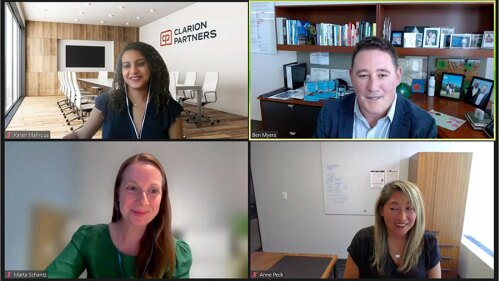Leading investors are developing approaches to better understand climate risk at the city or market scale, in addition to focusing on risk at the asset level, according to the research report Climate Risk and Real Estate: Emerging Practices for Market Assessment, released this month by ULI and global real estate investment management firm Heitman. During a ULI Virtual Fall Meeting panel discussion of the report, two Heitman executives explained how their firm applies climate risk analysis—at both the asset level and the community level—when evaluating investments.
Panel moderator Billy Grayson, executive director of the ULI Center for Sustainability and Economic Performance, said, “Investors have gotten really sophisticated really fast when it comes to understanding physical risk in their investment portfolios.” But investors are striving to better understand both the data and data sources that can help them compare risk at a market level.
The new report, a follow-up to Climate Risk and Real Estate Investment Decision-Making, which ULI and Heitman released in early 2019, expands the scope of the research to look at how those analyses are being extended to community-level risk. This includes how specific climate-related changes can affect asset pricing and demand; occupier demand and rental revenue; and the potential for higher loan rates, taxes, operating expenses, capital expenditures; and potentially the unavailability of insurance. Savvy investors also look at the mitigation measures already implemented by a community, those that are planned, and any revenue sources that may have been identified to fund those measures, the new report says.
“Investors are already making market-based decisions based on the limited information they already have about climate risk in these communities,” Grayson said. But the sophistication of those market analyses is “not where it needs to be,” he noted. “It’s really challenging right now to evaluate the resilience of the infrastructure of a city.”
Mary Ludgin, head of global research at Heitman, said, “It’s a daunting task to try to assess either asset-level or market-level risk, but it’s less daunting than trying to explain to an investor why their property has flooded or why flood insurance isn’t available in a specific location.”
Laura Craft, senior vice president of global ESG strategy for Heitman, emphasized the need to analyze both. “If you were just to assess the property-level risk, you could be negligent to the fact that the market has risk and could impact your investment value.”
Ludgin explained that “following the shift of people and jobs to the Sun Belt has been a reliable investment strategy for decades. But the risk inherent in that strategy hasn’t been fully acknowledged in real estate pricing.”
Among the factors Heitman considers in its analyses are the anticipated holding period for the investment, and the investment structure and their position in the capital stack. “Equity investments where we are in the first loss position make us much more sensitive to climate risk at the market level than do debt investments,” she noted.
Ludgin added that when investing in a property, Heitman is taking on exposure to how well prepared a city is for climate-related disasters as well as to more regularly occurring disruptions such as the flooding that rising sea levels have brought to many coastal cities.
“There will be winners and losers at the regional and market level,” Ludgin said.
Climate Risk and Real Estate was prepared through a collaboration among Heitman, Arup, Milliman, ULI Europe, and ULI’s Center for Sustainability and Economic Performance. ULI interviewed leading global real estate investment managers, institutional investors, and other public and private real estate and land use practitioners. Heitman, Arup, and Milliman contributed thought leadership and corresponding “deep dive” analysis to better understand how the industry’s view of climate risk is progressing and why climate-related risks have not yet been comprehensively priced into the market.
ULI members can access both volumes through Knowledge Finder.





